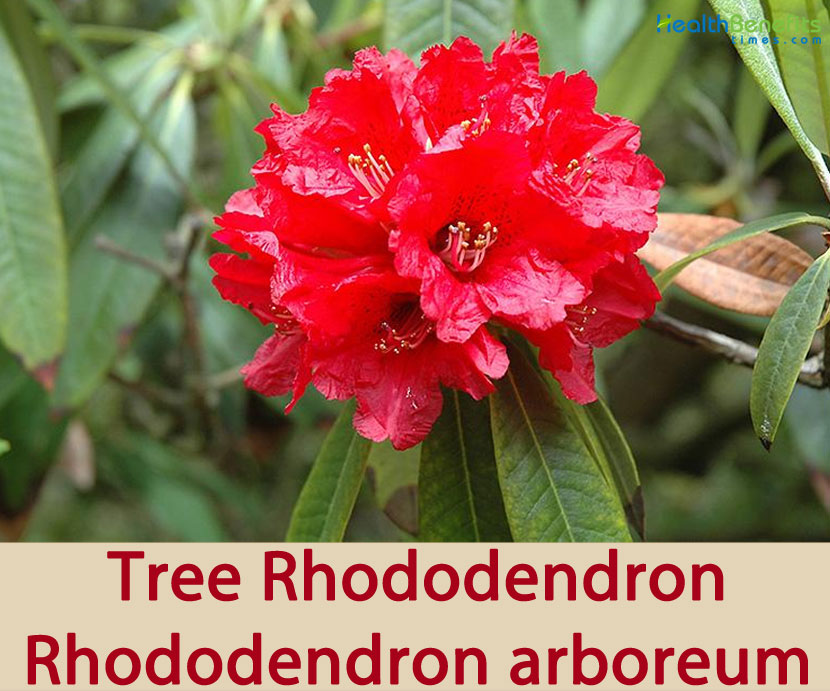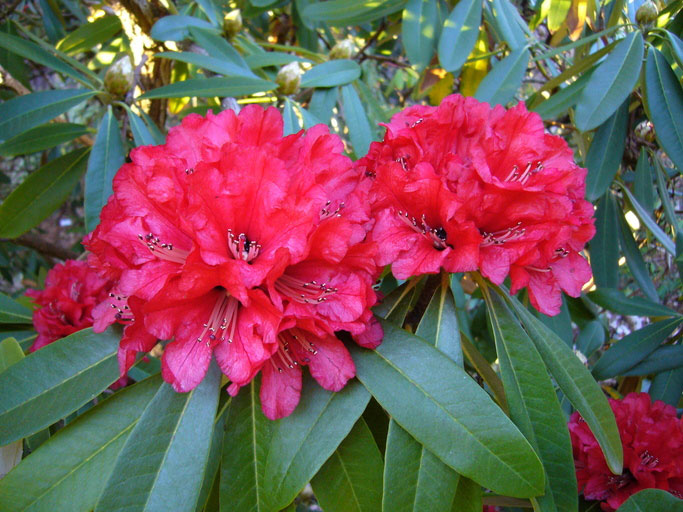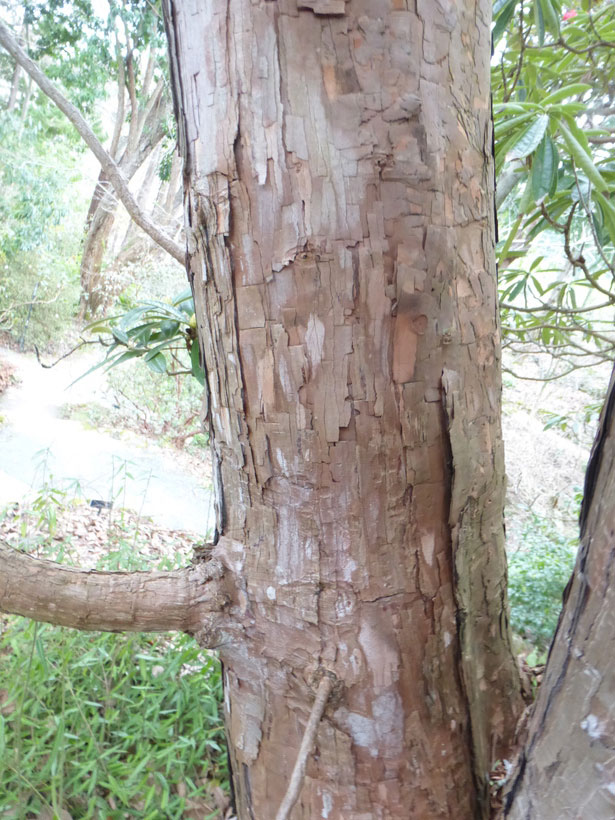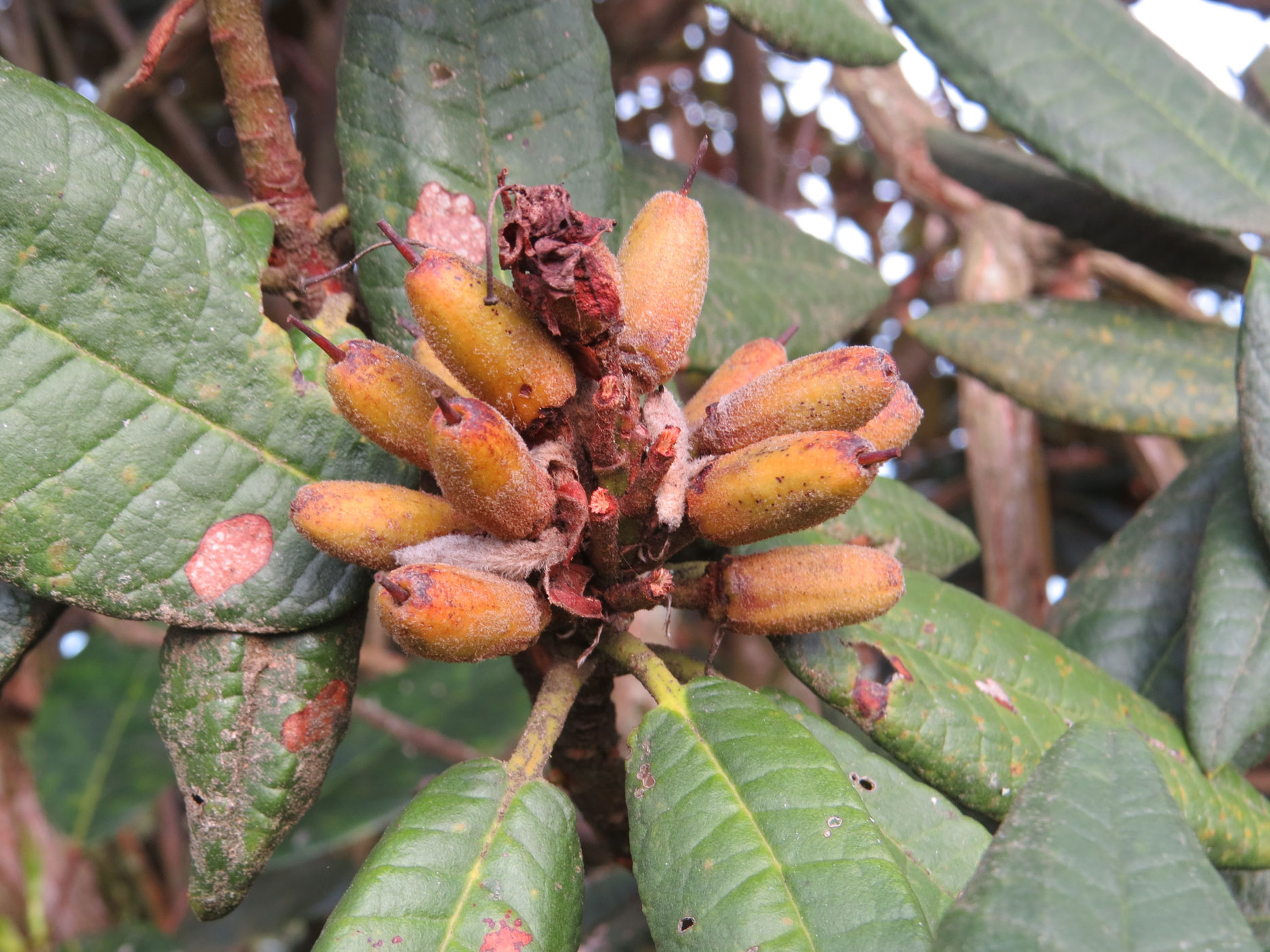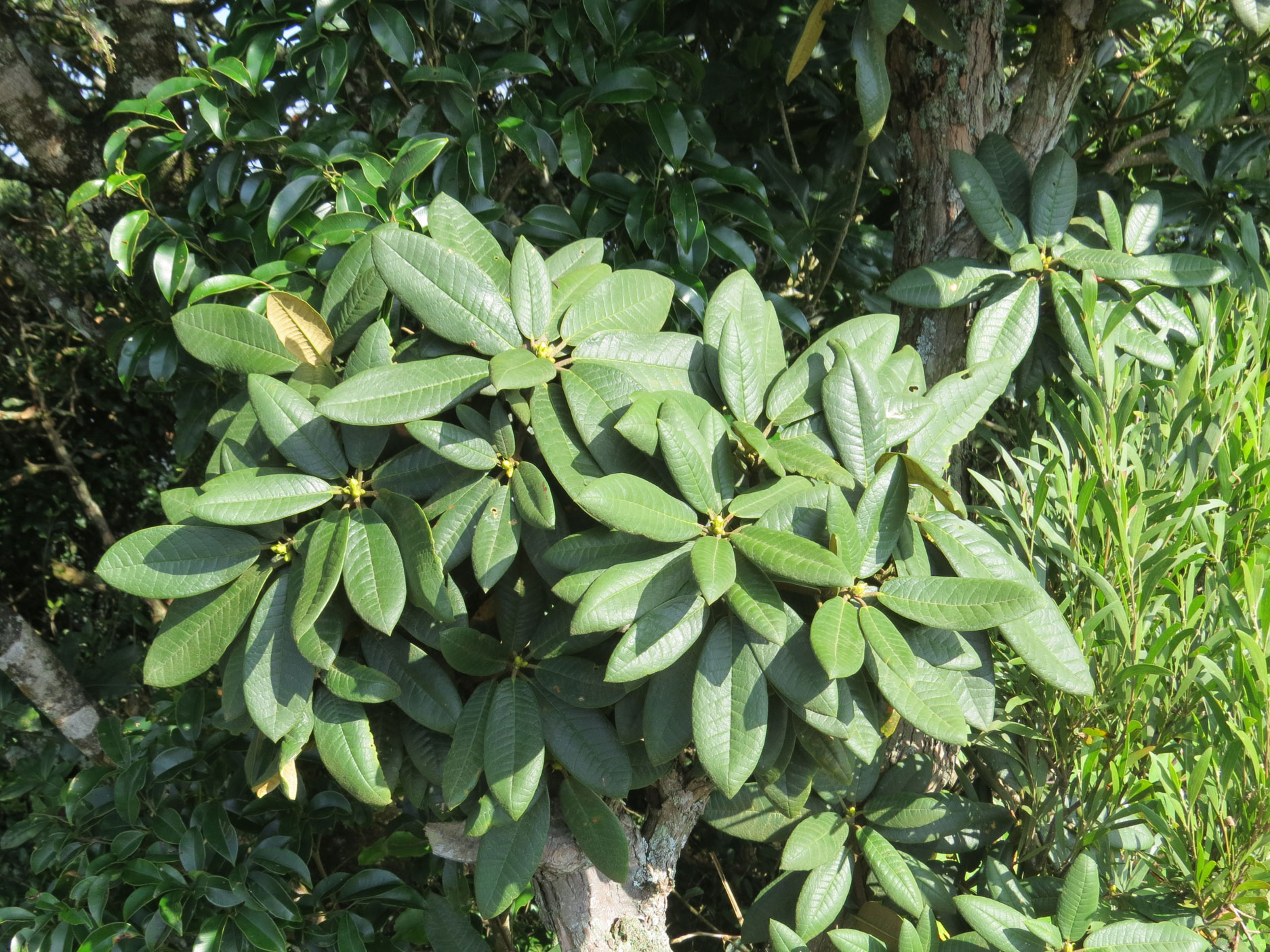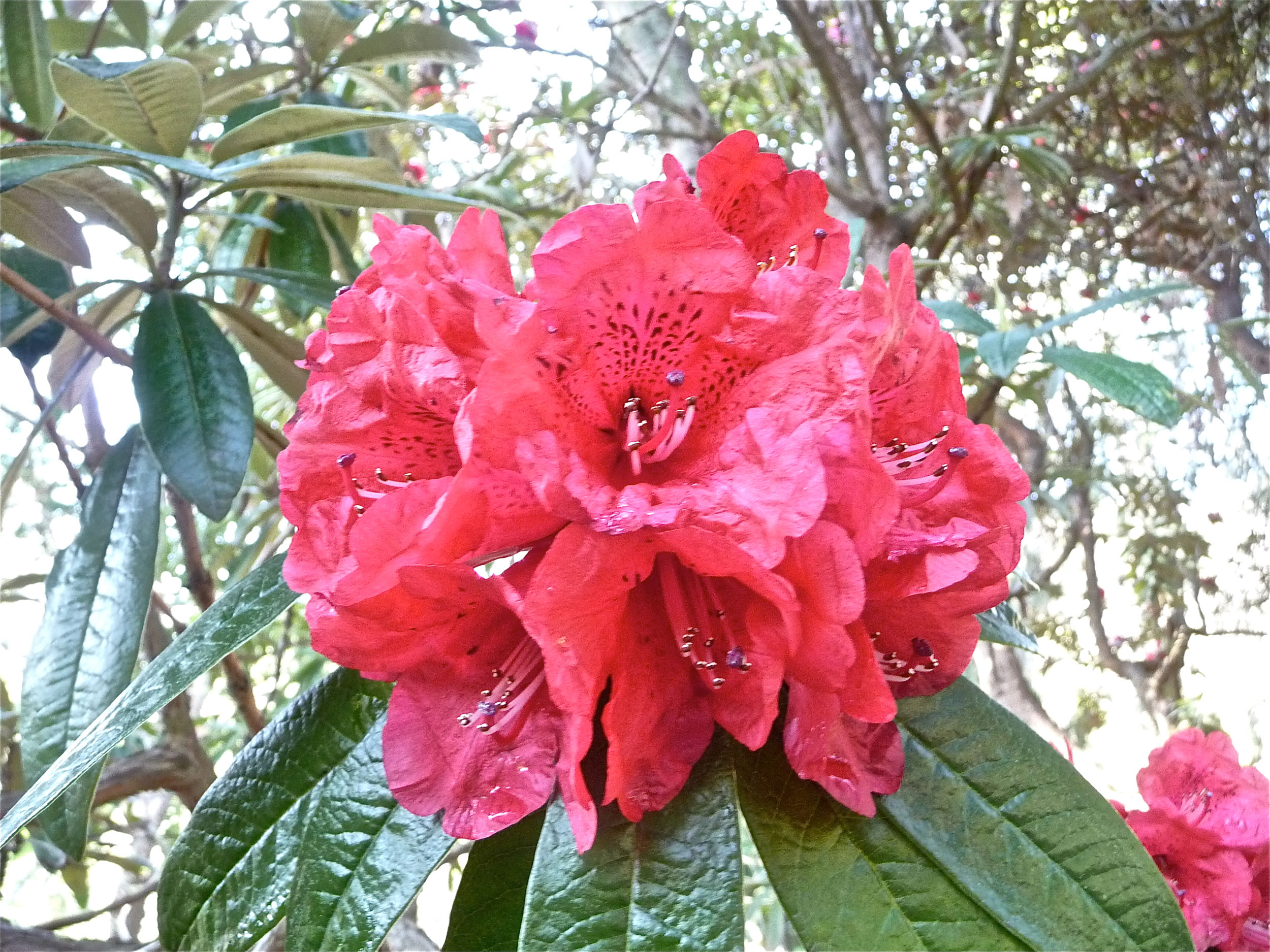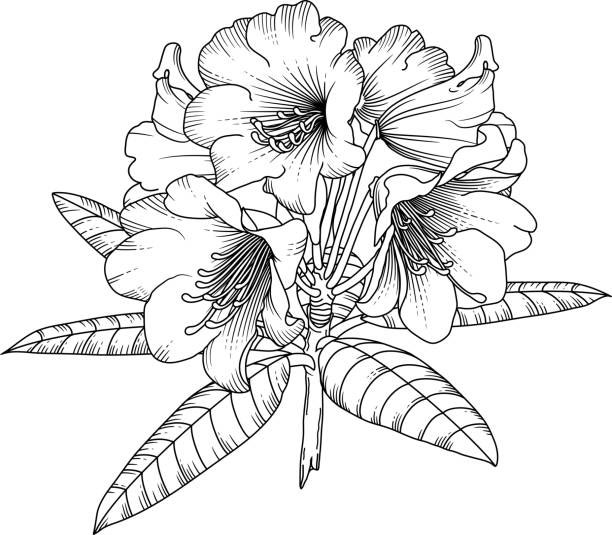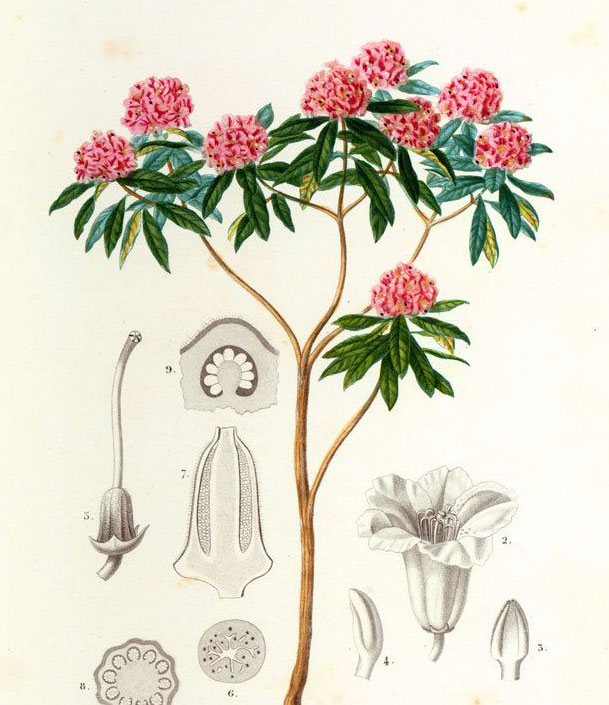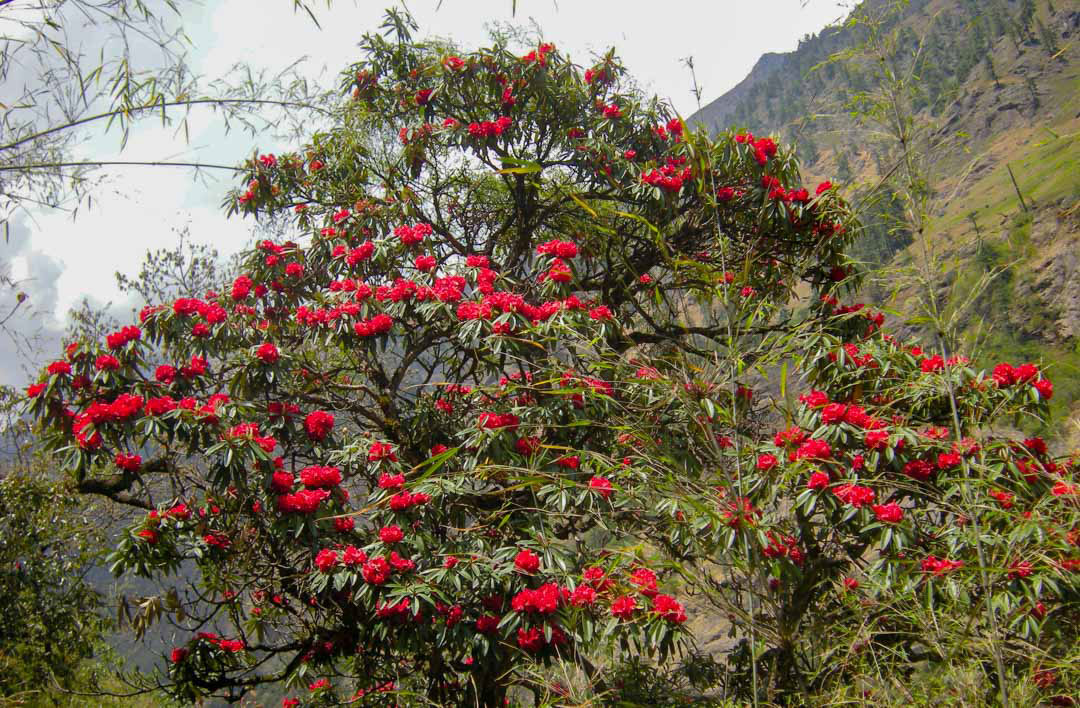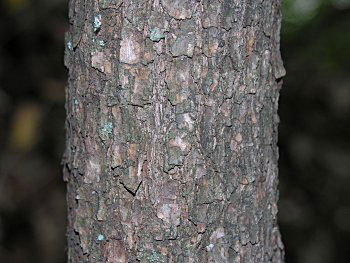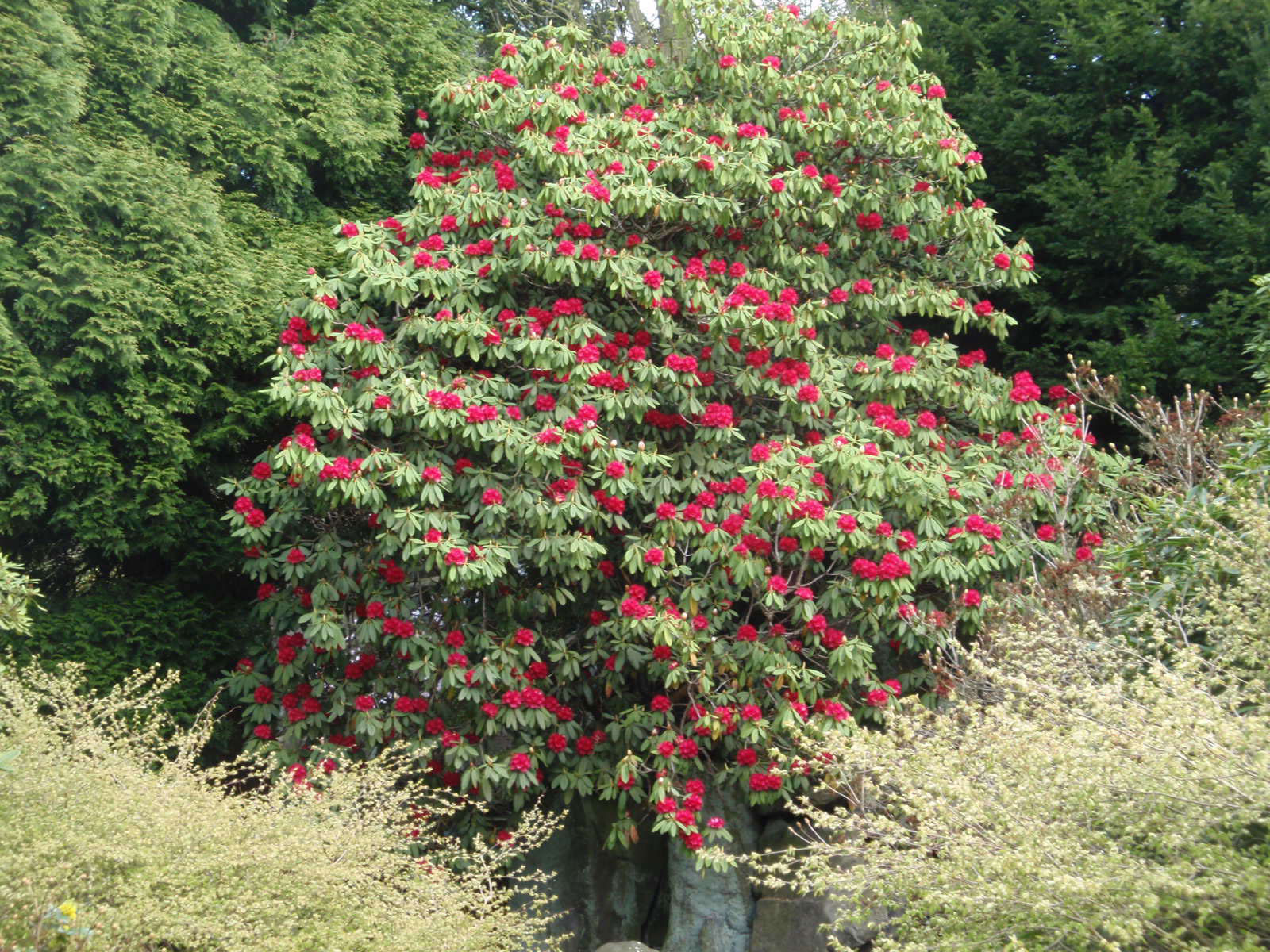The plant is often harvested from the wild for local use as a food, medicine and source of materials – the flowers and bark are ingredients of commercial cosmetic preparations. The flowers are sold in local markets and used as offerings in temples. The plant can be used as a pioneer species for restoring native woodland and is often grown as an ornamental in gardens. It plays a major role in traditional remedies for different diseases due to its phytochemical potential. It is widely cultivated in different parts of the world for to its aesthetic, commercial and medicinal values.
Tree Rhododendron Facts
| Tree rhododendron Quick Facts | |
|---|---|
| Name: | Tree rhododendron |
| Scientific Name: | Rhododendron arboreum |
| Origin | Bhutan, China, India, Myanmar, Nepal, Sri Lanka, Pakistan and Thailand |
| Shapes | Curved capsule central column composed of fine lobes, longitudinally ribbed; up to 3.8 cm long and 1.25 cm |
| Taste | Sour, sweet |
| Health benefits | Acts as anti-inflammatory, Pain killing ability, Good antioxidant, Good for diabetes, Treat diarrhea, Antimicrobial property, Good for heart, Protect liver, Prevention of cancer, Beneficial for Skin, Fight with Respiratory Disease |
| Name | Tree rhododendron |
|---|---|
| Scientific Name | Rhododendron arboreum |
| Native | Found in the Himalayas from Kashmir eastwards to Nagaland and widely grows in Bhutan, China, India, Myanmar, Nepal, Sri Lanka, Pakistan and Thailand |
| Common Names | Tree rhododendron |
| Name in Other Languages | Afrikaans: Rhododendron Albanian: Ashe Amharic: Rododonidironi (ሮዶዶንድሮን) Arabic: Alwardiat jins janabat (الوردية جنس جنبات) Armenian: Rhododendron Azerbaijani: Rododendron Basque: Rododendron Belarusian: Radadendran (рададэндран) Bengali: Raḍōḍēnaḍrana (রডোডেনড্রন), Lāligurāsa (লালী গুরাঁস) Bosnian: Rododendron Bulgarian: Rododendron (рододендрон), dŭrvesen rododendron (дървесен рододендрон) Burmese: Taungjalaut (တောင်ဇလပ်) Catalan: Neret Cebuano: Rhododendron Chichewa: Rhododendron Chinese: Dùjuān (杜鹃), shù xíng dù juān (树形杜鹃) Corsican: Rododendru Croatian: Rododendron Czech: Rododendron Danish: Rhododendron Dotyali: Lālī gurām̐sa (लाली गुराँस) Dutch: Rhododendron English: Tree rhododendron Esperanto: Rododendro Estonian: Rhododendron Filipino: Rododendro Finnish: Alppiruusu, Puualppiruusu French: Rhododendron, rhododendron en arbre Frisian: Rododendron Galician: Rododendro, Rododendro arbóreo Garhwal: Burans Georgian: Shkeri (შქერი) German: Rhododendron, baumartige, Alpenrose, Greek: Rododáfni (ροδοδάφνη) Gujarati: Mōṭāṁ phūlavāḷuṁ ēka bārē māsa līluṁ rahēnāruṁ jhāḍavuṁ (મોટાં ફૂલવાળું એક બારે માસ લીલું રહેનારું ઝાડવું) Haitian Creole: Rhododendron Hausa: Rhododendron Hawaiian: Rhododendron Hebrew: רודודנדרון Hindi: Lali Guransh, Burans, ek prakaar ka phal (एक प्रकार का फल), Burans (बुरांस), Lal buransh (लाल बुरांश), chalan, chiu, zalatai Hmong: Rhododendron Hungarian: Havas szépe Icelandic: Rhododendron Igbo: Rhododendron Indonesian: Rhododendron Irish: Róslabhrais a Italian: Rododendro, rododendro arboreo Japanese: Zhen zhoo (真珠) Javanese: Rhododendron Kannada: Rōḍōḍenḍrōn (ರೋಡೋಡೆನ್ಡ್ರೋನ್), Pu Kazakh: Rododendron (рододендрон) Khmer: Rhododendrons Kinyarwanda: Rododendron Korean: Jindallae (진달래) Kumaoun: Eras Kurdish (Kurmanji): Rododendron Kyrgyz: Rododendron (рододендрон) Latin: Rhododendron Lao: Rhododendron Latvian: Rododendrons Lithuanian: Rhododendron Luxembourgish: Rhododendron Macedonian: Rododendron (рододендрон) Maithili: Lālī gurām̐sa (लाली गुराँस) Malagasy: Rhododendron Malay: Rhododendron Malayalam: Kattupoovarasu, r’heādeādendreān (ര്ഹൊദൊദെംദ്രൊന്), kāṭṭupūvaraś (കാട്ടുപൂവരശ്) Maltese: Rhododendron Maori: Rhododendron Marathi: Mōṭhayā phulān̄cē ēka sadāharita asē phulajhāḍa (मोठया फुलांचे एक सदाहरित असे फुलझाड) Mizo: Chhawkhlei Mongolian: Rhododendron Myanmar (Burmese): Rhododendron Nepali: Rhododendron, Laligurans (लाली गुराँस) Norwegian: Rhododendron Odia: ରୋଡୋଡେଣ୍ଡ୍ରନ୍ | Pakistan: Burans, burus, chalan, chiu, zalatai Pashto: روډډوډرون Persian: گل صد تومانی, خرزه هندی درختی Polish: Rhododendron, Różanecznik drzewiasty Portuguese: Rododendro Punjabi: Rhododendron, Adrawal Romanian: Rhododendron Russian: Rhododendron (рододендрон), Rododendron drevesnyy (Рододендрон древесный) Samoan: Rhododendron Sanskrit: Kurvak Scots Gaelic: Ròs-chraobh Sesotho: Rhododendron Serbian: Rhododendron (рододендрон) Shona: Rhododendron Sindhi: رودوڊينڊرن Sinhala: Rhododendron, Maha ratmal, Maha Rath Mal, Asela mal Slovak: Alpská ruža Slovenian: Rhododendron Somali: Rhododendron Spanish: Rododendro Sudanese: Rhododendron Swahili: Rhododendron Swedish: Rhododendron, Trädrododendron Tajik: Rhododendron Tamil: Rōṭōṭeṉrāṉ (ரோடோடென்ரான்), Billi, Pili (பிலி) Tangkhul: Kokluiwon Tatar: рододендрон Telugu: Rhododendron, Rōḍōḍeṇḍrān erupu (రోడోడెండ్రాన్ ఎరుపు) Thai: Phạnṭhu̒ mị̂ phùm chnid h̄nụ̀ng (พันธ์ไม้พุ่มชนิดหนึ่ง), Khả dæng (คำแดง) Turkish: Rododendron Turkmen: Rododendron Ukrainian: Rhododendron (рододендрон) Urdu: Rhododendron Uyghur: Rhododendron Uzbek: Rhododendron Vietnamese: Rhododendron Welsh: Rhododendron Xhosa: Rhododendron Yiddish: Rhododendron (רהאָדאָדענדראָן) Yoruba: Rhododendron Zulu: Rhododendron |
| Plant Growth Habit | Much-branched, evergreen or deciduous shrubs or small tree |
| Growing Climates | Forests, thickets, slopes |
| Soil | Prefers moist but well-drained, leafy, humus-rich, acid pH soil, in dappled shade |
| Plant Size | 20 m (66 ft.) tall, though more usually 12 m (39 ft.) tall and broad |
| Bark | Bark gray-brownish, exfoliating into thin and small irregular flakes |
| Leaf | Stiffly leathery, oblong-lanceolate to oblong-oblanceolate, 10-20 cm long and 3.6 cm wide. Crowded towards the ends of branches, petiole is covered with white scales when young |
| Flowering season | April to May |
| Flower | Flowers are showy, red in dense globose cymes. Calyx- fine cleft, Corolla-tube spotted funnel shaped, Stamens-hypozygnous declining, Filaments are filiform, Anthers-ovate, and Style is capitate |
| Fruit Shape & Size | Curved capsule central column composed of fine lobes, longitudinally ribbed; up to 3.8 cm long and 1.25 cm |
| Seed | Seeds are minute, dark brown, compressed, thin linear having an obvolute membrane. |
| Taste | Sour, sweet |
| Plant Parts Used | Flowers, petals,, leaves and roots |
| Season | September – October |
| Health Benefits |
|
Plant Description
Tree rhododendron is a much-branched, evergreen or deciduous shrubs or small tree with a wide crown that normally grows about 20 m (66 ft.) tall, though more usually 12 m (39 ft.) tall and broad. It has been recorded as reaching heights of up to 66 feet (20 m). This plant holds the Guinness Record for World’s Largest Rhododendron. The tree discovered in 1993 at Mount Japfu in Kohima district of Nagaland, India, holds the Guinness Record for the tallest Rhododendron at 108 ft. measured at the time of discovery which is still growing. The plant is found growing in forests, thickets and slopes. The plant prefers moist but well-drained, leafy, humus-rich, acid pH soil, in dappled shade. The trunk is often much branched, crooked or gnarled. Bark is reddish brown, soft and rough, exfoliating in thin flakes.
Leaves
Leaves are stiffly leathery, oblong-lanceolate to oblong-oblanceolate, 10-20 cm long and 3.6 cm wide. Crowded towards the ends of branches, petiole is covered with white scales when young. Upper surface is with more or less deeply impressed veins, lower surface is with a compacted to dense and spongy white to fawn indumentum composed of dendroid hairs, occasionally also with a loose floccose rufous upper layer.
Flowers
Flowers of R. arboreum range in color from a deep scarlet, to red with white markings, pink to white. Bearing up to twenty blossoms in a single truss this rhododendron is a spectacular sight when in full bloom. It is reported that the bright red forms of this rhododendron are generally found at the lower elevations. Flowers are showy, red in dense globose cymes. Calyx- fine cleft, Corolla-tube spotted funnel shaped, Stamens-hypozygnous declining, Filaments are filiform, Anthers-ovate, and Style is capitate. Flowering normally takes place in between April to May.
Fruit
Fertile flowers are followed by curved capsule central column composed of fine lobes, longitudinally ribbed; up to 3.8 cm long and 1.25 cm. Seeds are minute, dark brown, compressed, thin linear having an obvolute membrane. Fruiting will occurs on the month of September till October.
Health benefits of Tree rhododendron
Tree rhododendron leaves and flowers have been put to various medicinal purposes traditionally. Latest research has evaluated anti-diabetic, antioxidant, anti-inflammatory, antimicrobial, heart and liver protective property of Tree rhododendron flower. These and other health benefits of Tree rhododendron flower is listed below:
1. Acts as anti-inflammatory
Various Ayurvedic and homeopathic medicines have used Tree rhododendron flowers and leaves for treating body inflammation and treat gout, rheumatism, bronchitis and arthritis. Research with Rhododendron arboreum showed important anti-inflammatory properties. Animal studies showed ability of Tree rhododendron flower extract to cure paw edema in rats. Flavonoid, tannin, Saponin and other phytochemicals are believed to be responsible for such effect. Two such chemical with strong anti-inflammatory property – Quercetin and Rutin are found in Tree rhododendron flower. Quercetin is known to relieve inflammation of prostate, kidney and urinary bladder. Rutin is helpful in treating painful ulcers in mouth and gastrointestinal tract and used for osteoarthritis.
2. Pain killing ability
Young leaves of Tree rhododendron have been traditionally used in treating headache. Paste made from tree leaves is applied to forehead to relieve head ache. Leaves of Tree rhododendron are astringent and used as poultice in treating wounds and reducing skin inflammation. Flower juice is helpful in relieving stomach ache. Animal studies with extract of burans flower and leaves have displayed potential to reduce stimulus of pain in rats.
3. Good antioxidant
Various phytochemicals have been isolated from Burans leaves and flower which have high antioxidant properties. They exhibit beneficial property in getting rid of harmful free radicals in body. Burans flower juice is thus a great antioxidant drink for your heart, liver, kidney and skins. Lab studies confirm antioxidant properties of Tree rhododendron flower and leaf extract and suggest its utilization in therapeutics.
4. Good for diabetes
Local people from Nepal have been using Tree rhododendron flower for treating diabetes. Latest studies have confirmed anti-diabetic potential of flower and suggested its uses as functional food in treating type I and type II diabetes. Methanol extract of Tree rhododendron flower have showed in-vitro anti-diabetic activity suggesting its potential in development of new medicines for diabetes. Animal studies with flower extract showed reduced blood sugar and cholesterol levels in rats. This property can be attributed to presence of compound hyperin with antioxidant property and ability to inhibit action of certain glucose enzymes.
5. Treat diarrhea
Traditionally flowers and leaves of Tree rhododendron have been used as home remedy over diarrhea and dysentery. Dried petals powder and paste of dried leaves powder are found helpful in relieving diarrhea. Lab studies with ethyl acetate extract of burans flowers showed potential antidiarrheal activity. Similarly animal studies showed effectiveness of Tree rhododendron flower extract in treating castor oil and magnesium sulfate induced diarrhea in rats. Flower extract showed ability to reduce frequency of stools in rats. Phytochemicals mainly flavonoids, tannins, sterols and reducing sugars were considered responsible for such ability to treat diarrhea.
6. Antimicrobial property
Flowers and leaves of Rhododendron arboreum consists of wide range of phytochemical many of them have independently reported antimicrobial properties. These include various bioactive steroids, Saponin and flavonoids. Lab studies with alcoholic extract of flower have confirmed its effectiveness over wide strains of bacteria in various concentrations. Quercetin and p-coumaric acid are two such flavonoids present in flower with established antimicrobial action. P-courmaric acid is believed to exhibit antibacterial action and help modify gut flora.
7. Good for heart
Tree rhododendron flower juice is good for heart. It helps in lowering blood pressure and bad cholesterol. Various phytochemicals in flower juice offer antioxidant property and protect heart from oxidative stress and reduces risk of stroke and other heart disorders. Quercetin and rutin are two flavonoid found in Tree rhododendron flower juice which have established its benefits for heart. Quercetin supplementation is prescribed in treating hypertension, atherosclerosis and other heart disorders, while rutin helps in preventing blood clots which pose risk of heart attacks. Drinking Tree rhododendron flower juice is thus good for heart and circulatory system.
Local people consume Tree rhododendron flower when it blooms and is believed to protect them from illness onset a change of weather including allergies, asthma, hives or hay fever. Quercetin in Tree rhododendron flower juice helps preventing allergic response of immune cells in body.
8. Protect liver
Tree rhododendron flower have been used in Ayurvedic medicinal forms to reduce cholesterol and as liver tonic. Animal research showed that alcoholic extract of Tree rhododendron flower and leaves was helpful in preventing liver damage by carbon tetracholoride intoxication. Studies thus confirm the traditional hepato-protective potential of flower. Investigations have attributed antioxidant properties of quercetin related flavonoids, saponins and phenolic compounds in flower and leaves. Tree rhododendron flower juice can also be enjoyed to relieve hangover.
9. Prevention of cancer
Key phytochemicals have been isolated from Tree rhododendron flower which independently have established their ability in preventing cancer. Quercetin and Rutin present in Tree rhododendron flower inhibits growth of cancer cells and reduces risk of cancer. Together with other phytochemicals they offer antioxidant properties which prevent damage of body cells leading to mutation and development of cancer.
10. Beneficial for Skin
Tree rhododendron flower juice is considered beneficial in preventing aging and bring back skin glow. It is strong antioxidant and offers benefits in preventing damage of skin cells by oxidizing action of sunlight and pollution. It offers anti-inflammatory and anti-bacterial properties to skin to treat acne, eczema, rashes and other skin inflammation. Leaves are astringent and poultice; it offers ability to heal wounds. Drinking its flower juice is good way to enjoy its benefits to your skin. Applying Tree rhododendron juice to your skin can help reduce wrinkles, itching and other skin inflammation.
One can try this homemade face pack using Tree rhododendron flower – Make powder of shade dried flower. Mix this powder with honey and apply to your face. Leave it for 30 minutes before you wash it with cold water. It will offer glowing, clean skin free of wrinkles.
11. Fight with Respiratory Disease
Using Tree rhododendron is beneficial in treating respiratory diseases. Mix its dried leaves with tobacco, and inhale the smoke from it. It provides relief in respiratory disorders. Taking the powder of leaves of Tree rhododendron flower is also beneficial in respiratory diseases.
Traditional uses and benefits of Tree rhododendron
- Young leaves are made into a paste and then applied to the forehead in the treatment of headaches.
- The juice of the bark is used in the treatment of coughs, diarrhea and dysentery.
- Decoction of the flowers is used to check a tendency to vomit, especially if there is also a loss of appetite.
- The juice of the flowers is used in the treatment of menstrual disorders.
- Petals are eaten to assist the removal of any animal bones that have become stuck in the throat.
- It possesses numerous medicinal properties in the treatment of dysentery, diarrhea, detoxification, inflammation, fever, constipation, bronchitis and asthma.
- Nectar is brewed to make wine and is effective in diarrhea and dysentery.
- Snuff made from the bark of the tree is excellent cold reliever.
- Juices of petals are good drink for summer and heart tonic.
- Petroleum ether extract decreases the rate of heartbeat and contraction in isolated heart of
- Wine made from the flowers, known as ‘Guranse’, is commonly drunk in parts of the Himalayas – it is said to be very pleasant and also to be very efficacious in the prevention of altitude sickness.
- The tincture of dried leaves of Rhododendron arboreum has been used in gout & rheumatism.
- Dried flowers are supposedly highly efficacious in checking diarrhea and blood dysentery.
- Fresh and dried corolla that is acid-sweet in nature is given when fish bones get struck in the gullet.
- Flower juice helps in increasing endurance and can be used as sports drink to enhance performance.
- It is believed that the paste of bark helps in healing the cuts.
- Honey-mixed drink of flowers is used to cure blurry vision and asthma.
- Flower aqueous extract used as a food coloring agent.
- Dried flowers fried in ghee are used to stop the blood dysentery.
- Crushed flowers are snuffed to stop the nasal bleeding.
- Flower juice is used to cure fever, stomach ache and heart-related problems.
- Dried leaf tincture is used for the treatment of rheumatism and gout.
- Leaves and bark are used to reduce the roughness of the skin.
- Bark juice is used to cure coughs, piles and liver disorders.
- Decoction of the roots is used to cure early stage of cancer.
Culinary Uses
- The tender leaves are used as a cooked vegetable.
- Flowers are consumed raw or cooked.
- Flowers are sometimes simply pickled by adding salt and chili.
- In hilly areas, the flowers of Rhododendron arboreum with sweet & sour taste are used in the preparation of squash, jams, jellies and local brew.
- Fresh petals are used to prepare chutney known as barah ki chutney.
- Flower buds are used as a vegetable.
- Local people pick Tree rhododendron’s fresh flowers and make juice, jam, jelly, and chutney out of them.
Other Facts
- It is the national flower of Nepal.
- In India it is the state tree of Uttarakhand and state flower of Nagaland.
- The juice of the leaves is spread over cots and beds to get rid of bed lice.
- Wood is used in turnery, it can also be used to make charcoal and for fuel.
- Wood is much used in Nepal where it is used for making household implements, building small houses and fences.
- Planks of the wood are carved to make boxes, cupboards and other furniture.
- It is a very good fuel, burning well with a long-lasting heat – over collection of the wood for fuel, and also for making charcoal, has become a cause for conservation concern.
- Grained wood is used for making ‘khukri’ handles, packsaddles, gift-boxes, gunstocks and posts.
- Flowers & leaves are fitted in long ropes made of munja grass & tied around the houses including temples as decorations.
- Postal stamp was issued by the Indian Postal Department to commemorate this flower.
- The main stem and branches of the Tree rhododendron are used as fuel wood.
- Tree rhododendron flower is also a part of worship. People offer them in temples while worshiping.
- The tallest Rhododendron arboreum is measured of 108 ft.
Tree rhododendron Chutney (sauce)
Ingredients
- Five-six flowers of Tree rhododendron
- Coriander one bunch
- Mint half a bunch
- Sesame Seeds two tablespoon
- Chopped onions two tablespoon
- Chopped ginger one teaspoon
- Lemon juice two teaspoon
- Salt as per taste
- Honey half tea spoon
Direction
- Blend Tree rhododendron flowers, fresh coriander, and fresh mint after washing them properly.
- Toss sesame seeds in a pan over heat and add to the blender.
- Add chopped onions, ginger and blend to achieve desired consistency of sauce or chutney.
- Remove to a serving bowl and add salt, lemon juice and honey. Mix well.
Tree rhododendron Paratha (bread)
Ingredients
- Two cups Wheat flour
- Half cup gram flour
- Half a cup chopped Tree rhododendron
- Two tablespoon chopped onion
- One teaspoon chopped fresh coriander
- One teaspoon grated ginger
- Salt as per taste
- Half teaspoon turmeric powder
- Chopped green chilly (Optional)
Directions
- Sieve the flour and gram flour together and mix together all the ingredients.
- Add water and knead to till the dough becomes stiff.
- Make a dough ball of approximately 60 gm. and then roll it out with a rolling pin.
- Cook it on a flat frying pan, apply ghee and cook till done.
- Serve with pickle and yogurt.
Precautions
- The leaves are poisonous.
- The flowers can cause intoxication in large quantities.
- High doses may lead to toxicity.
- Flower or its juice may interfere with action of some medications for heart and diabetes.
- Leaves of the Tree rhododendron are toxic, and hence, it requires a proper and precise invention to make this juice available for people to drink for health purposes.
References:
https://gd.eppo.int/taxon/RHOAB
http://germoplasma.iniaf.gob.bo/gringlobal/taxonomydetail.aspx?id=477
http://www.efloras.org/florataxon.aspx?flora_id=2&taxon_id=200016337
https://davesgarden.com/guides/pf/go/94950/#b
http://www.theplantlist.org/tpl1.1/record/tro-50060254
http://www.efloras.org/florataxon.aspx?flora_id=5&taxon_id=128386
https://en.wikipedia.org/wiki/Rhododendron_arboreum
http://temperate.theferns.info/plant/Rhododendron+arboreum
http://www.flowersofindia.net/catalog/slides/Tree%20Rhododendron.html
https://www.slideshare.net/lunasharma/rhododendron-arboreum-169973791
https://www.cabi.org/isc/datasheet/47234


